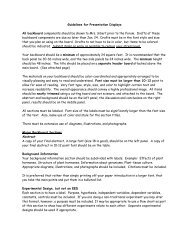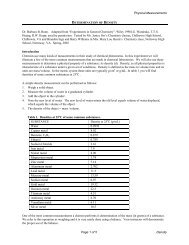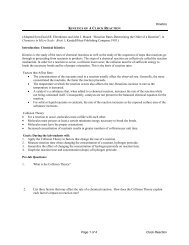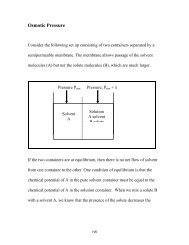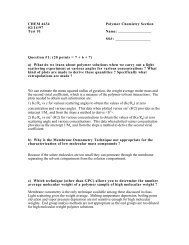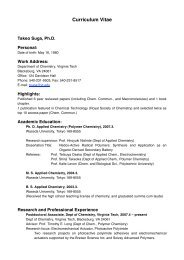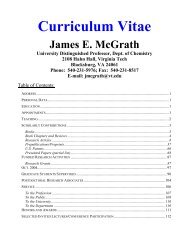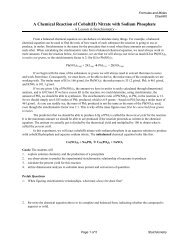Carlier Group Gaussian User Manual - Virginia Tech
Carlier Group Gaussian User Manual - Virginia Tech
Carlier Group Gaussian User Manual - Virginia Tech
Create successful ePaper yourself
Turn your PDF publications into a flip-book with our unique Google optimized e-Paper software.
<strong>Carlier</strong> <strong>Group</strong> <strong>Gaussian</strong> <strong>User</strong> <strong>Manual</strong> 41<br />
/Wiberg<br />
14. Basis Set Superposition Error: Counterpoise<br />
Correction<br />
A. Introduction<br />
Basis Set Superposition Error (BSSE) is an error incurred during the calculation of a<br />
super-molecule (i.e., dimer). Suppose two molecules, A and B join together to form AB<br />
dimer, as shown below.<br />
A + B AB<br />
The “dimerization energy” is not simply ΔE=E AB -(E A +E B ). The term ΔE we would obtain<br />
in this way would be artificially low due to this BSSE. In this example, suppose that<br />
each fragment is calculated using 12 basis function orbitals, and the dimer AB, being<br />
composed of one A and one B fragment is calculated using 24 basis function orbitals.<br />
When the electronic energy of AB is calculated, all 24 basis function orbitals are<br />
available to each A or B fragment, which means that electrons from one A fragment can<br />
use the orbitals of the B fragment to stabilize it, and vice versa. The direct result of this<br />
is that the energy of the dimer AB will be too low.<br />
B. Running a Counterpoise calculation<br />
In order to correct for the BSSE imposed when calculating clusters of molecular<br />
fragments (e.g. dimers, solvated monomers, etc.), a counterpoise correction can be<br />
implemented on an optimized geometry. The subject of how best to compensate for<br />
BSSE is quite complex and counterpoise is just one possible way to estimate the BSSE.<br />
But the counterpoise correction is defined as follows:<br />
ΔE CP = E AB – (E A{AB} +E B{AB} )<br />
Where E A{AB} signifies the energy of fragment A calculated using all the basis function<br />
orbitals available to dimer AB.<br />
You will need to get the optimized geometry from your previous geometry optimization<br />
and put this in your input file. But you will need to be absolutely certain of your atom #<br />
assignments to properly create the input file.<br />
Every atom of the structure in the input file must be correctly assigned to its proper<br />
molecular fragment. Use Molden or GaussView or Spartan and examine each atom to<br />
ensure each atoms numeric assignment (e.g. O is atom #1 above, Li is atom #2, a C is<br />
atom #3). Be very, very careful. A misassignment will destroy a BSSE<br />
calculation. Make careful notes as you do this. Some people find it useful to



